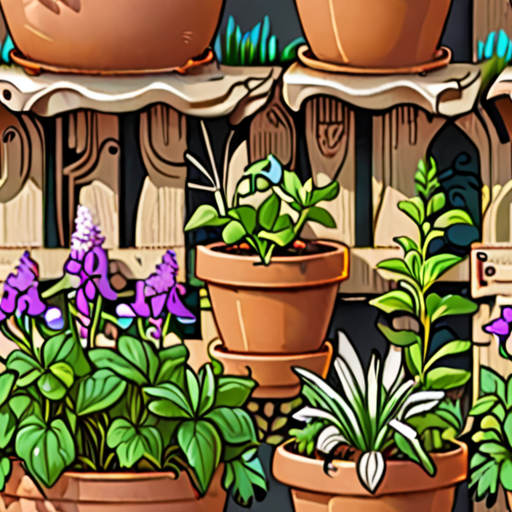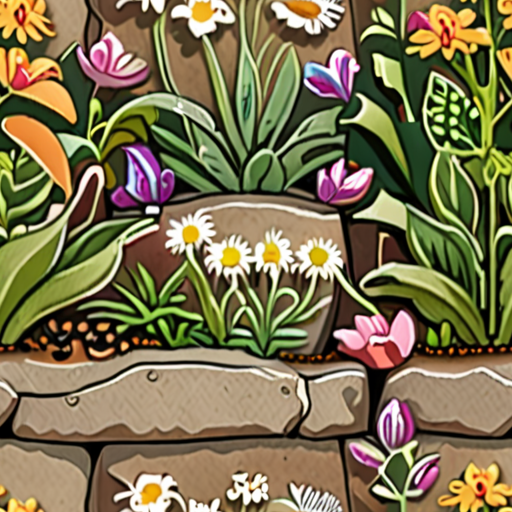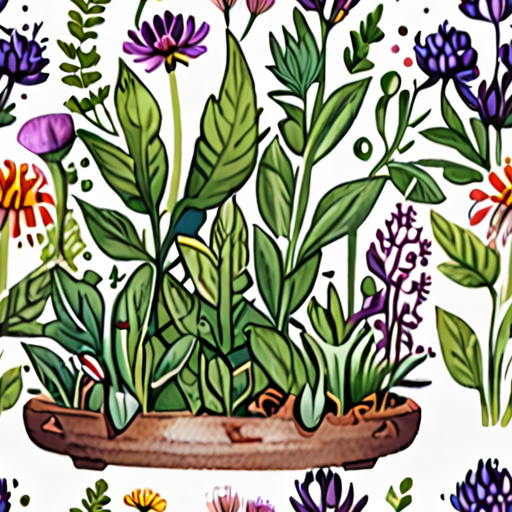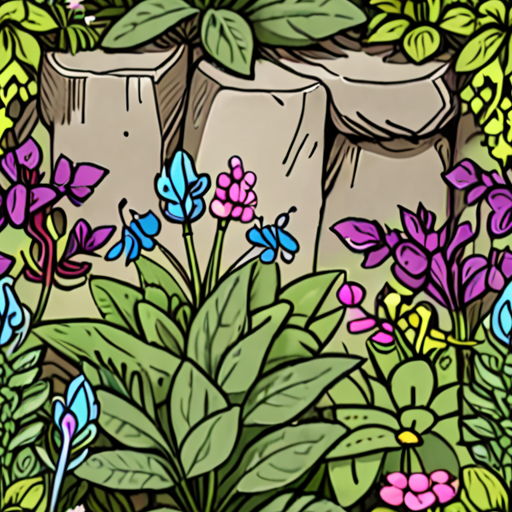For centuries, heirloom herbs have been prized for their unique flavors, aromas, and medicinal properties, making them a staple in many traditional gardens. These rare and resilient herbs offer a glimpse into the past, connecting us to our ancestors who carefully cultivated and preserved these precious varieties. As interest in sustainable living and preserving heritage continues to grow, many gardeners are turning to heirloom herb gardening as a way to reconnect with nature and cultivate a deeper appreciation for the art of gardening.
What is an Heirloom Herb?
An heirloom herb refers to a variety of herbs that have been saved and handed down through generations, often originating from family gardens or local communities.
- These herbs are typically open-pollinated, meaning they can be saved and replanted from year to year, allowing gardeners to preserve their unique characteristics and flavors.
- Heirloom herbs often have rich histories and cultural significance, reflecting the diversity and complexity of human relationships with plants.
Characteristics of Heirloom Herbs
Some common characteristics of heirloom herbs include:
- Diverse flavor profiles and aromas
- Variations in texture and appearance
- Unique growth habits and requirements
- Rich histories and cultural significance
Benefits of Growing Heirloom Herbs
Growing heirloom herbs offers several benefits, including:
- Preservation of genetic diversity and crop resilience
- Access to unique and complex flavors and aromas
- Cultural connection and appreciation for heritage varieties
- Opportunities for experimentation and innovation in gardening and cooking
Popular Heirloom Herb Varieties
Some popular heirloom herb varieties include:
- Basil – ‘Genovese’ and ‘Sweet Basil’
- Mint – ‘Peppermint’ and ‘Spearmint’
- Chives – ‘Fine Leaf’ and ‘Garlic Chives’
- Oregano – ‘Greek Oregano’ and ‘Italian Oregano’
Getting Started with Heirloom Herbs
To get started with growing heirloom herbs, consider the following steps:
- Research and select heirloom herb varieties suitable for your climate and growing conditions
- Obtain high-quality seeds or seedlings from reputable sources
- Prepare soil and provide optimal growing conditions for your herbs
- Learn about pruning, harvesting, and preserving techniques to maximize yields and enjoyment
Herbs That Should Not Be Planted Next to Each Other
When growing herbs, it’s essential to consider companion planting to maximize growth, flavor, and pest resistance.
- Fennel and Dill: These two herbs can inhibit each other’s growth and may cause them to become leggy.
- Basil and Mint: Basil can be overwhelmed by mint’s aggressive spreading habit, while mint can stunt basil’s growth.
- Cilantro and Coriander: These two herbs belong to the same family and can cross-pollinate, leading to reduced flavor and aroma.
- Parsley and Carrots: Parsley can inhibit carrot growth due to its deep taproot, which can compete with carrots for water and nutrients.
- Rosemary and Sage: Both rosemary and sage are members of the mint family and can be invasive, potentially choking out other herbs.
- Thyme and Oregano: Thyme can be susceptible to oregano’s fungal diseases, making it essential to separate these herbs.
- Lavender and Cucumbers: Lavender’s strong scent can repel beneficial insects that cucumbers need for pollination.
- Chives and Garlic: Chives can absorb sulfur compounds from garlic, reducing their flavor and aroma.
- Marjoram and Lemon Balm: Marjoram can be overwhelmed by lemon balm’s rapid growth and spread.
By understanding which herbs should not be planted together, you can create a harmonious and thriving herb garden.
What Does Heirloom Mean in Gardening?
In gardening, the term “heirloom” refers to varieties of plants that have been saved and handed down through generations, often within families or communities.
- Heirloom seeds are typically open-pollinated, meaning they can be saved and replanted year after year, allowing gardeners to preserve and share these unique varieties.
- These seeds are often passed down through family lines, community gardens, or seed exchanges, making them a vital part of preserving genetic diversity in crops.
When growing heirloom vegetables, fruits, or flowers, gardeners can expect to encounter unique characteristics, such as:
- Diverse colors, shapes, and sizes
- Distinctive flavors and aromas
- Higher nutritional value due to the preservation of genetic traits
Old Seed encourages gardeners to explore the world of heirloom gardening, experimenting with new varieties and sharing knowledge with others to promote sustainability and biodiversity in our food systems.
For more information on heirloom gardening and sustainable agriculture, visit our Sustainable Agriculture page.
Discover the rich history and cultural significance behind heirloom varieties by exploring our Heirloom Gardening section.
Learn how to save and store heirloom seeds effectively on our Seeds Saving Tips page.
When to Start an Herb Garden
The ideal time to begin an herb garden depends on various factors, including your location, climate, and the types of herbs you wish to grow.
- In temperate climates, spring is often considered the best season to start an herb garden, as the weather is generally mild and there is ample moisture in the soil.
- However, in regions with a long growing season, you may be able to plant herbs in the fall, allowing them to mature before the first frost.
- If you’re starting from seeds, it’s essential to check the specific germination requirements for each herb variety, as some may require warmer or cooler temperatures.
- Transplanting established herbs can be done at any time of the year, but it’s crucial to acclimate them to outdoor conditions gradually to prevent shock.
Some popular herbs that thrive in cooler temperatures include:
- Mint
- Parsley
- Dill
- Cilantro
On the other hand, warm-season herbs like basil, rosemary, and thyme prefer the heat of summer.
As a general rule, it’s best to start herb gardens in the spring or early summer, when the risk of frost has passed and the soil has warmed up.
Keep in mind that some herbs, like chamomile and lemon balm, can be grown year-round in containers indoors, providing protection from extreme temperatures and pests.
By choosing the right herbs for your climate and starting them at the optimal time, you’ll be well on your way to enjoying a thriving and fragrant herb garden.
The Best Layout for an Herb Garden
When designing an herb garden, it’s essential to consider the layout to maximize space, promote healthy growth, and facilitate easy maintenance.
- Square Foot Gardening: Divide your herb garden into smaller sections, each measuring about 4 feet by 4 feet. This layout allows for efficient use of space and makes it easier to access individual herbs.
- Raised Beds: Build raised beds using wood, stone, or brick to create a visually appealing and functional herb garden. Raised beds can be made in various shapes and sizes, depending on your available space.
- Circular or Spiral Layout: Create a circular or spiral pattern with your herbs to add visual interest and promote air circulation. This layout is ideal for small spaces and can be easily adapted to fit irregularly shaped gardens.
- Keyhole Design: Use a keyhole design to create a compact and accessible herb garden. This layout features a central path leading to a circular planting area, making it perfect for small spaces and mobility-impaired individuals.
Regardless of the layout you choose, remember to incorporate the following essential elements:
- Trellises or Supports: Provide support for climbing herbs like mint, lemongrass, and rosemary to prevent them from becoming leggy and promote healthy growth.
- Irrigation System: Install a drip irrigation system or soaker hose to deliver water directly to the roots of your herbs, reducing evaporation and runoff.
- Mulch and Compost: Mulch around your herbs to retain moisture, suppress weeds, and regulate soil temperature. Add compost regularly to maintain fertile soil and promote healthy plant growth.
By incorporating these layouts and essential elements, you’ll be well on your way to creating a thriving and beautiful herb garden that will provide you with fresh flavors and aromas all season long.
What Are the Easiest Herbs to Grow?
I’ve been growing herbs for years, and I can confidently say that some are easier to grow than others.
- Basil
- Cilantro
- Dill
- Mint
- Parsley
- Rosemary
- Sage
- Thyme
These herbs are perfect for beginners because they’re relatively low maintenance and can thrive in a variety of conditions.
Why Choose Easy-to-Grow Herbs?
Easy-to-grow herbs are ideal for those who want to start small and experiment with different varieties without committing to a large garden space.
- They require minimal care and attention
- Can tolerate some neglect
- Are less prone to pests and diseases
- Can be grown indoors or outdoors
Tips for Growing Easy Herbs
To get the most out of your easy-to-grow herbs, follow these simple tips:
- Choose a location with plenty of sunlight
- Water regularly, but avoid overwatering
- Fertilize occasionally
- Prune regularly to promote healthy growth
Conclusion
Growing easy-to-grow herbs is a great way to start your gardening journey or add some fresh flavor to your cooking.
With these simple tips and a little patience, you’ll be enjoying homegrown herbs in no time!





0 Comments